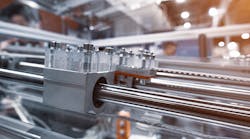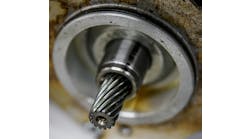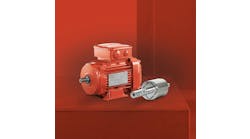Linear-motion technology is the basis for many critical components used in industrial machinery. Learn more about product innovations from Hiwin, Aerotech, Nexen Group, Nippon Pulse, Ewellix and Bosch Rexroth in here.
These same manufacturers discussed the overall market for linear-motion technology: what customer desires are driving the market; the biggest challenges facing technological advancement; and the future of linear-motion product design trends in the world of IIoT and Industry 4.0 and beyond.
Compact components and power density
“In general, the precision control market is looking to solve space issues, especially in multi-axis applications where side-by-side motion is required,” says Bob White, technical sales manager at Nippon Pulse. The ability to get smaller-diameter motors with higher force capabilities can drive higher density systems, he explains.
“Miniaturization trends are forcing manufacturers to increase the power density of their products or develop new solutions to offer more power in less space,” says Will Morris, category manager at Allied Electronics & Automation. “That is required to reduce the machine footprint and optimize the overall layout to get lighter equipment that requires less energy to be utilized.”
Intuitive tools to expedite design
“Once a design is solidified, the products within should seamlessly transfer to the quote and ordering process with minimal effort on both the customer’s and the supplier’s side. This speeds up the process and eliminates errors,” says Richard Vaughn, automation engineering manager at Bosch Rexroth.
“Designs which offer a complete axis solution bring more value to the marketplace versus individual components,” says Justin Hillukka, lead engineer for power transmission and custom products at Nexen Group. “Engineering capacity is limited in many organizations, so offering solutions that make the design cycle more efficient adds value.”
End-user delivery
Speed to deliver automation equipment to the end users is becoming an ever-increasing priority in these markets, says Bosch Rexroth’s Vaughn. “Rapidly changing technology in all areas of manufacturing requires that production facilities be able to incorporate new designs or change over to the next generation of products at record pace,” he explains.
“A key theme for linear-motion products is ease of use,” says Brian Fink, product manager at Aerotech. “With ever-increasing pressure on delivery, both end users and machine builders strive to get their products to market as quickly as possible. It is highly advantageous to select motion stages, controllers and other components that are easy to integrate and operate right out of the box.”
Reduced downtime and higher precision
“Developers of motion control and automation systems are being pushed to deliver higher throughput, reduced downtime—higher reliability and reduced maintenance—and better quality, in terms of increased precision, all at the same time,” says Art Holzknecht, engineering manager at Hiwin.
“Indeed, the underlying theme of smart products affects linear motion products, as well. In order to reach complete control of the equipment and implement advanced features, such as predictive maintenance or real-time performance optimization, sensors and electronics need to be integrated on linear-motion systems,” says Morris of Allied.
Less maintenance means increased production
“Maintenance-free operation is also becoming a clear need across many industries, as end users need to reduce the maintenance costs and related downtime to improve their productivity and bottom-line results,” says Morris of Allied.
“Innovative motion-system engineers are responding by bringing down the cost of direct-drive linear-motor systems through highly optimized designs, incremental technology improvements and streamlined manufacturing,” says Holzknecht of Hiwin.
Market challenges
The desire for smaller, faster and more intuitive and accurate linear-motion products is driving new feature designs and technology innovations. What are some of the challenges facing this product market, and how is industry responding?
- Bringing new technology to a broader customer base: Without specialized knowledge in the system, it’s more difficult for new markets to adopt new technology without a lot of education. “Advances in drive technology using advanced servo control algorithms and sophisticated software have taken the complexity out of the customer experience,” says Hiwin’s Holzknecht. “Setting up a direct drive is easier than ever, with smart tools that guide the user through every step.”
- Reaching delivery goals with slow order fulfilment: High demand and low supply have been exacerbated by the pandemic. “Increasing the adoption of more common and standard products by machine designers can allow motion suppliers to streamline and therefore increase their inventories, enabling greater control over product deliveries,” says Vaughn of Bosch Rexroth.
- Understanding design tradeoffs: Finding the right system for new customers and doing so on time and on budget means customizing each system by first understanding the system design objectives. “Machine builders and system integrators are often faced with difficult design tradeoffs,” says Fink of Aerotech. “It is crucial for motion control and stage suppliers to understand and appreciate these tradeoffs and the implications thereof. Only with this deep understanding is it possible for suppliers to design and manufacture motion control equipment that achieves as many needs of the target buyers as possible.”
IIoT implications
The next industrial revolution is shaping every machine component, including linear-motion products, which are smarter, faster and more open. As with many components, it starts with data collection. “Capturing machine data offers big opportunities to gain knowledge,” explains Bosch Rexroth’s Vaughn. “These new motion products enable ways to monitor, analyze and in turn improve like never before.”
For this data ultimately to be valuable, it needs to communicate quickly and efficiently with the controller. “These devices should work in harmony with the controller to deliver a higher level of functionality to users,” says Fink of Aerotech. “Therefore, the design of the controller is at least as important, if not more so, than having a high-performing positioning device.”
Also read: Linear motion control for all
IIoT and industry 4.0 continue to put pressure on linear shaft designs, especially in the area of feedback devices used to close the servo loops, says Nippon Pulse’s White. “These devices integrate with smart controllers that provide a wide array of data on motor health to upstream systems, along with key information about the mechanical elements that make up the machine axes,” he says.
Speed is still the name of the end game, whether designing, communicating, upgrading or troubleshooting. “Being able to connect to a motion control or servo drive remotely via an internet connection is key to fast troubleshooting. Expert engineers who are not on-site can respond quickly to machine faults, get diagnostic information and keep a motion control system running before a critical-line-down situation,” says Holzknecht of Hiwin.
5 predictions for the future of linear motion
- “More applications in microelectronics manufacturing, drug discovery/life sciences and precision automation will adopt linear-motion-driven systems to produce their products,” says Hiwin’s Holzknecht.
- “Smart products and fit-for-purpose solutions are key themes that will guide new developments in linear motion. By adding onboard intelligence in the products, we can create new value that can bring innovation in traditional industries and applications, says Morris of Allied Electronics & Automation.
- “I see a trend toward fully automated and intuitive tools that enable motion-component customers to be completely self-sufficient. This includes online sizing and selection, CAD generation, quoting and ordering all from a website. Additionally, in the future the customer’s equipment will be able to program their motion online with a virtual twin of the equipment, well ahead of the physical parts arriving to gain further advantage over short project timelines,” says Bosch Rexroth’s Vaughn.
- “I expect that the future will see more of a convergence on mechanical design optimization; but more important than that is the integration of the mechanics with advanced controller features and capabilities,” predicts Aerotech’s Fink.
- “Future trends include continued innovation on size reduction, improved magnetics, robust and lower cost feedback elements and a wider array of sealing options for different market requirements,” explains White from Nippon Pulse.






